

Do school dress codes end up body-shaming girls? - CNN. But if the girls are wearing the clothes that are primarily being offered to them, don't we have a problem here?
Some schools have unequal rules, such as the boys can wear shorts. However, the girls can not wear skirts above the knee level. This situation makes some girls feel ashamed about their bodies. The clothes should not be a standard to estimate girls. – xinzhufan
Pearlman said her daughter, now 13, had been told in the fall by a teacher that she couldn't wear yoga pants because the boys would get turned on and then be embarrassed.

Then, for two days in a row, her daughter, who is 5 feet 7 inches tall, was told she violated the school's dress code for wearing shorts that were too short: They are supposed to be longer than students' fingertips when they have their arms at their sides. She had to put on boys' gym shorts instead and return to class. Pearlman -- a licensed clinical social worker and founder of The Family Coach, a private practice helping families resolve everyday problems including discipline, sibling rivalry and sleep -- headed to her computer to vent.
Fashion Nova, H&M, Zara: Why we can’t stop buying fast fashion. If you’ve bought clothes in the past decade, odds are that at least one item came from a fast fashion brand.
Fashion should consider the requirements of different groups. – xinzhufan
Stores like Zara and H&M, two of the largest retailers in the world, still hold a stronghold over most people’s shopping habits, even with the rise of online shopping brands.
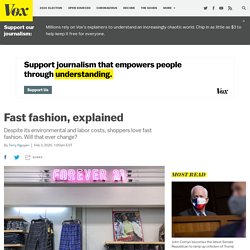
These big, brightly lit stores seemed to pop up in malls overnight sometime in the late 2000s, carrying everything from skinny jeans to work blouses to cocktail dresses, often for significantly less money than stores like Gap or Nordstrom. Still, these shopping behemoths aren’t without controversy. The sustainable fashion conversation is based on bad statistics and misinformation. Whenever a fashion brand makes a commitment to offset its carbon emissions, it needs to explain why it matters.
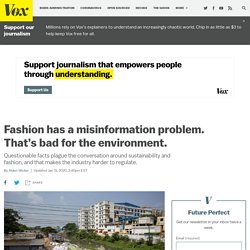
Whenever a journalist like me writes a story about, say, activists protesting London Fashion Week, I also need to tell you why you should care and should keep reading. McKinsey: How Business Can Respond to COVID-19. This post originally appeared on McKinsey & Company.
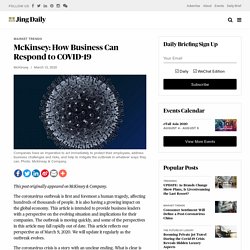
The coronavirus outbreak is first and foremost a human tragedy, affecting hundreds of thousands of people. It is also having a growing impact on the global economy. This article is intended to provide business leaders with a perspective on the evolving situation and implications for their companies. The outbreak is moving quickly, and some of the perspectives in this article may fall rapidly out of date. This article reflects our perspective as of March 9, 2020.
Wallet Explores the ‘Masters of Marketing’ With Latest Issue. BANKING ON IT: With the new issue of Wallet, publisher and curator Elise Olsen delved into marketing in fashion.

She said the issue “was inevitable when talking about the fashion industry and that kind of machinery. Fashion communication, marketing, advertising — the system of it and the business of it — is a very interesting field to tap into. I also think it’s an aspect of fashion that is looked upon as almost perverse or grotesque in a way. It was nice to talk about that and to try to have a discourse around that aspect of fashion. The “Masters of Marketing” issue features interviews with self-employed publicist Gia Kuan, Dries Van Noten’s brand communications director Patrick Scallon and PR Consulting’s Pierre Rougier.
Anna Wintour On Vogue's Politics, Fur, and What She's Wearing to the Met Gala. On Friday, CNN’s Christiane Amanpour sat down with Anna Wintour, interviewing the legendary editor and Condé Nast artistic director about some of the fashion industry’s most pressing topics.

In the 22-minute long video Amanpour got Wintour to speak on everything from the women featured in Vogue, to playing tennis with Roger Federer. Sustainability. The Freewheeling, Copyright-Infringing World of Custom-Printed Tees.
The Internet makes counterfeits spread widely, such as Facebook ads and Instagram ads. The product should respect copyright. – xinzhufan
Environmental Impacts of the Fashion Industry — SustainYourStyle. The apparel industry accounts for 10% of global carbon emissions.
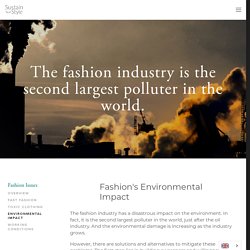
The global fashion industry is generating a lot of greenhouse gases due to the energy used during its production, manufacturing, and transportation of the millions garments purchased each year. Synthetic fibers (polyester, acrylic, nylon, etc.), used in the majority of our clothes, are made from fossil fuel, making production much more energy-intensive than with natural fibers. Most of our clothes are produced in China, Bangladesh, or India, countries essentially powered by coal. The Biggest Fake News in Fashion.
An article on the OneGreenPlanet site, for example, asserts that “the $3 trillion fashion industry is the second most polluting industry, just behind oil,” and then links to a piece on the EcoWatch site, which then quotes Eileen Fisher, the designer who made sustainability part of the platform for her namesake brand and who has been given awards for her work in this space.
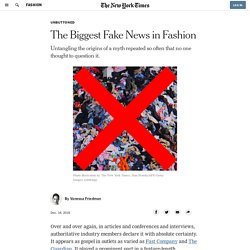
When queried, Ms. Fisher said she believed she originally got her information from “The True Cost,” a 2015 film by Andrew Morgan, and that she believed it was also discussed by the Glasgow Caledonian Fair Fashion Center. When Cara Smyth, the vice president of Glasgow Caledonian New York College, was asked, she also said she thought the claim derived from the film. But when I asked Mr. Coronavirus hits fashion industry, garment workers go unpaid. Subscribe to Outbreak, a daily newsletter roundup of stories on the coronavirus pandemic and its impact on global business.
Coronavirus influences everyone's daily life, especially the low-income groups. – xinzhufan
It’s free to get it in your inbox.
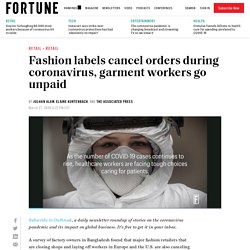
A survey of factory owners in Bangladesh found that major fashion retailers that are closing shops and laying off workers in Europe and the U.S. are also canceling their sometimes already completed orders, as workers often go unpaid. A report released Friday by Mark Anner, director of Pennsylvania State University's Center for Global Workers' Rights, says the coronavirus crisis has resulted in millions of factory workers, mostly women from rural areas, being sent home without the wages or severance pay they are owed. Burberry to make hospital gowns and masks for the NHS. Buy Better, Wear Longer, Dispose Smarter: Know Your Clothes Like a Pro. Fashion brands nowadays are becoming more eco-aware, and so are consumers.

From production to disposal, fashion retailers and upscale designers alike are rethinking the effects their fabrics have on the environment. Even though we tend to see fashion’s ecological impact as a brand focused problem, as consumers, we can play an important part in creating a path toward a sustainable, and more importantly a zero-waste future. It is as simple as changing our mind-set and being more mindful about the choices we make. All it takes is to gain a little more knowledge about the clothing we wear. The textile industry draws significantly upon the ecosystem for the raw materials that create our fabrics, but some production processes tend to be more “unfriendly” than others. Brands are making commitments. How to Decipher “Sustainable Fashion” in 2020.
Welcome to Sustainable Style, a new series in partnership with the New Standard Institute, where we'll be publishing stories devoted to the fashion and beauty industry's effects on the environment.
"Fashion contributes over 8 percent of all greenhouse gases". The fashion industry can help with greenhouse gas reduction if they use more sustainable materials. – xinzhufan
#CleanSeas Break-Up PSA: Christmas Edition "Home for the Holidays"
Stop using plastic bottles and bags is the most effective way to protect our environment. Excessive packaging leads to environmental pollution. – xinzhufan
The DIY Lockdown Fashion Trend That’s Taking Over Instagram. Animal Crossing players design luxury fashion on the game.
I'm playing this game now, the player can design different patterns for the figure. Fashion is in everywhere. – xinzhufan